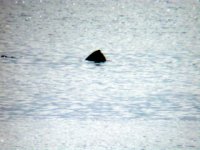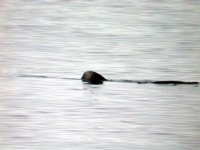The Swaro was tested with Swaro x30 fixed, their x45 fixed and x60 employing the Swaro x20-x60 zoom.
The Pentax was tested only with fixed eyepieces giving x30, x45 and x60.
Sorry, I don't know Swaro part numbers. The Pentax eyepieces are designated by their focal length, 10.5mm FL gives x60, 14mm FL gives x45, and 21mm FL gives x30 on the PF100.
I typically use x30 and x45 eyepieces for most of the long range digiscoping. These Pentax eyepieces are fabulous, big apertures, little or no vignetting and excellent image quality over entire aperture.
I sometimes use a low cost 32mm FL Super Plossl for digiscoping, giving about x20. These low cost astro eyepieces are pretty good but their image quality drops off outside the central 75% of the aperture.
I have used the x60 for digiscoping, but the depth of focus is too small, making focusing difficult. Strangely though, its great for close ranges, say 100 metres for those really up close shots!
There are two main advantages to using a 100mm aperture scope for digiscoping, one being its light gathering capability, thereby reducing exposure times, the other its higher resolution.
Astronomers will tell you that their refracting astro scopes are capable of an overall magnification of x60 per inch of aperture. These spotting scopes that we use have more optical elements in them to provide an upright image of the correct handedness, so one should expect to downgrade maximum potential magnification to say x50 per inch, ie. x2 per millimetre.
This means that a 100mm scope should be capable of a total magnification of around 200 times. An 80mm scope would be capable of 160 times, and a 65mm of 130 times.
The Pentax PF100 seems to run out of steam somewhere around 200 to 220 times, ie it won't let you use a x60 eyepiece at full zoom, leastways there is no more information available from the image.
Used at a maximum overall magnification of 180, the system works to my satisfaction, allowing me to use the x45 eyepiece over the full range of the zoom.
However the zoom on the CP4500 seems to produce a softer image near its maximum of x4, so I tend only to go to x3 if possible.
I only use manual focus on the CP4500 which cuts down on shutter lag as well as producing sharper images. Half cocking the shutter and using a remote manual cable seems pretty fool-proof.
I also use a 6-24 zoom rifle scope as a view finder; target designation and location is a major difficulty. Using a long range rifle scope mounted along side the PF100 means that target acquisition is trivial. You can set the rifle scope to minimum zoom giving a huge FOV, and lock onto the target with the rifle scope's crosshairs.
The main problems of long range digiscoping for me are poor atmospheric tranmission caused by haze and mistiness, as well as perturbations to the refractive index of the air due to wind and thermal convection currents.
Haze and mist are just problems to live with and overcome, but convection currents disturbing the air can be minimzed.
As I am trying to ID sharks by their fins, the majority of the optical path is over the sea. The land heats up quickly compared to the sea's surface, and therefore most thermal distortions are present in that part of the optical path that traverses the land. Consequently photographing from the cliff edge produces more consistant images with less defocusing due to thermal effects.
Wind disturbances are generally less troublesome as often sharks bask during periods of tranquil heat, usually when there is little or no wind. Also, having a large 100mm aperture minimises exposure times and thereby minimises the cumulative effects or short term compressions and rarefaction in the air.
My orginal design requirement was to achieve a resolution of 2mm at 500 meteres, and this system meets that. Exposure times of around 3milliseconds or less are routine at ISO 100 under reasonable conditions.
Remaining problems are lack of co-operation from the sharks, they don't seem to appreciate that shooting into the sun is difficult. The system is very heavy, the scopes are mounted on a Manfrotto 501 head and 055 tripod.
Here are 3 images.
The Oystercatcher was at 130+ metres on a dull day, exposure time 23msec.
Dorsal fin and snout, shot into the sun, 3000metres, 2.5milliseconds.
Dorsal fin, 1000 metres, 3milliseconds.
Just got the 65mm yesterday, images are looking very good. With all three Pentax eyepieces there is little or no vignetting. Focus snaps in very sharply, though it might seem a trifle fast, it's more sensitive than the 100mm scope.
Hope this helps
possum







